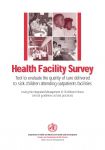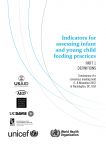What is an indicator?
A programme indicator in public health is basically a number, proportion, percentage or rate that helps measure ( “indicate”) the extent to which planned activities have been conducted (process and output indicators) and programme achievements have been made (outcome and impact indicators).
There is a logical ”flow” of indicators from inputs through impact. Plans should always include clear and measurable indicators that go beyond monitoring only the “process” to include also the “outcome”, that is what the intervention should lead to—as this is the main reason why certain activities have originally been planned. For example, a plan includes training courses for health providers on the management of a sick child. This is done: -> to improve health providers’ case management skills of sick children -> to improve how children are managed (outcome) -> to improve child health, e.g. reducing child deaths (impact).
Type of indicators
Input indicators
These indicators refer to the resources needed for the implementation of an activity or intervention. Policies, human resources, materials, financial resources are examples of input indicators.
Example: inputs to conduct a training course may include facilitators, training materials, funds.
Process and output indicators
Process indicators refer to indicators to measure whether planned activities took place. Examples include holding of meetings, conduct of training courses, distribution of medicines, development and testing of health education materials.
Output indicators add more details in relation to the product (“output”) of the activity, e.g. the number and categories of health providers trained in case management or communications skills, the number and type of radio spots produced and broadcast.
Example: the output of a training course on case management may be the number of medical assistants trained and, consequently, the number or proportion of them with improved knowledge and skills in case management.
Indicators should also monitor the quality of the activities conducted, based on a number of established quality criteria or standards.
Example: indicators to monitor the quality of a communication training course may include the ratio facilitator to participant, the total duration of the training, the percentage of total training time spent practising the communication skills, the number of caregivers counselled per participant, the proportion of participants trained that were followed up with skill reinforcement visits within 4 weeks of training.
These indicators are useful management tools to monitor implementation and its quality. However, they do not provide information on the results and impact of the activity.
Outcome indicators
Outcome indicators refer more specifically to the objectives of an intervention, that is its ‘results’, its outcome. These indicators refer to the reason why it was decided to conduct certain interventions in the first place. They are the result of both the “quantity” (“how many”) and quality (“how well”) of the activities implemented.
Example: the outcome of a training of health providers in the Integrated Management of Childhood Illness (IMCI) should be improved management of sick children under 5 years old, e.g. the proportion of sick children correctly managed by the trained health providers.
These indicators are usually measured through surveys. Coverage indicators measure the extent to which the target population (e.g. children under-five) has received—and therefore has been reached by—the intervention.
Examples: proportion of under-five children with suspected pneumonia treated with antibiotics, proportion of under-five children with diarrhoea given oral rehydration therapy, proportion of infants 0-5 months old who are exclusively breastfed.
These indicators, therefore, allow us to know whether the desired outcome has been generated.
It may take time before final outcomes can be measured. A number of intermediate outcome indicators should therefore be identified for all the intermediate changes that the intervention is expected to bring about and that will eventually lead to the final outcome. This helps us know whether we are progressing towards achieving the expected final outcome.
Impact indicators
Impact indicators refer to the health status of the target population: reduction in child mortality, reduction in child morbidity, improved child nutritional status.
These indicators do not show progress over relatively short periods of time. It is then the logical flow of indicators described above which enables a more regular and frequent monitoring of changes.
Targets and monitoring
Targets
A programme target is a quantified goal or objective that a programme plans to achieve by a certain date.
Examples: under-five mortality will be reduced by two thirds between 1990 and 2015; 80% of children 0-5 months old will be exclusively breastfed by (year); 80% of under-five children with suspected pneumonia will be treated with antibiotics by (year); 90% of under-five children with acute diarrhoea will receive oral rehydration therapy by (year); 70% of under-five children in malaria risk areas will sleep under insecticide-treated bednets by (year); 100% of primary health care facilities will be staffed with providers trained in IMCI (integrated management of child health) and regularly supplied with essential medicines by (year).
Targets should be set for all types of indicators in the logical flow from process to outputs, outcomes and impact. Obviously, the targets set for impact and outcome indicators should be based on the targets for the output and process indicators, rather than on their own, as they strongly depend on and result from them.
Monitoring
Indicators should be monitored on a regular basis and plans for monitoring them should be included in the master plan for any intervention. Monitoring provides information not only about what is happening and how activities are implemented but also about why things are or are not happening. Monitoring of indicators helps suggest how the intervention needs to be modified during implementation to address the issues identified. In this way, monitoring informs planning.
Child health indicators
IMCI health facility indicators
 Priority indicators and supplemental measures on both health worker’s skills and health system supports for IMCI (Integrated management of childhood illness) at primary health care facility level are included in Annex D and E, respectively, of the WHO manual on the IMCI health facility survey:
Priority indicators and supplemental measures on both health worker’s skills and health system supports for IMCI (Integrated management of childhood illness) at primary health care facility level are included in Annex D and E, respectively, of the WHO manual on the IMCI health facility survey:
Indicators for assessing infant and young child feeding practices
 Indicators for assessing infant and young child feeding practices include 8 core indicators and 7 optional indicators, are population-based and can be derived from household survey data.
Indicators for assessing infant and young child feeding practices include 8 core indicators and 7 optional indicators, are population-based and can be derived from household survey data.
The indicators are the result of a consensus meeting held in Washington DC, USA, 6-8 November 2007. Developments in knowledge and recommendations in this area prompted the revision and expansion of the indicators which had been developed earlier for breastfeeding (1991) and for complementary feeding (2002).
Indicators for care for child development
 A set of indicators for care for child development has been developed to assess the status and quality of implementation of the intervention - including inputs, health providers’ performance and caregivers’ practices, and its impact.
A set of indicators for care for child development has been developed to assess the status and quality of implementation of the intervention - including inputs, health providers’ performance and caregivers’ practices, and its impact.
“Countdown to 2015” indicators and profiles
 The “Countdown to 2015” initiative collects indicators on key maternal, neonatal and child interventions to reduce maternal and child mortality, in line with the related Millennium Development Goals, in 75 countries which represent 95% of all maternal, neonatal and child mortality.
The “Countdown to 2015” initiative collects indicators on key maternal, neonatal and child interventions to reduce maternal and child mortality, in line with the related Millennium Development Goals, in 75 countries which represent 95% of all maternal, neonatal and child mortality.
Impact and coverage indicators across the continuum of care are presented in graphs as country profiles.
Core indicators by the Commission on information and accountability for Women’s and Children’s Health
 The Commission, in its report “Keeping promises, measuring results”, has selected a core of 11 indicators on maternal, neonatal and child health, aligned with the indicators of the Millennium Development Goals and with the continuum of care for maternal, newborn, and child health.
The Commission, in its report “Keeping promises, measuring results”, has selected a core of 11 indicators on maternal, neonatal and child health, aligned with the indicators of the Millennium Development Goals and with the continuum of care for maternal, newborn, and child health.
The indicators include three impact indicators and eight coverage indicators.
Impact indicators on the health status of women’s and children’s health.
- Maternal mortality ratio (deaths per 100 000 live births);
- Underfive child mortality, with the proportion of newborn deaths (deaths per 1000 live births);
- Children under five who are stunted (percentage of children under five years of age whose height-for-age is below minus two standard deviations from the median of the WHO Child Growth Standards).
Coverage indicators on key interventions on women’s and children’s health.
- Met need for contraception (proportion of women aged 15-49 years who are married or in union and who have met their need for family planning, i.e. who do not want any more children or want to wait at least two years before having a baby, and are using contraception);
- Antenatal care coverage (percentage of women aged 15–49 with a live birth who received antenatal care by a skilled health provider at least four times during pregnancy);
- Antiretroviral prophylaxis among HIV-positive pregnant women to prevent vertical transmission of HIV, and antiretroviral therapy for women who are treatment-eligible;
- Skilled attendant at birth (percentage of live births attended by skilled health personnel);
- Postnatal care for mothers and babies (percentage of mothers and babies who received postnatal care visit within two days of childbirth);
- Exclusive breastfeeding for six months (percentage of infants aged 0–5 months who are exclusively breastfed);
- Three doses of the combined diphtheria, pertussis and tetanus vaccine (percentage of infants aged 12–23 months who received three doses of diphtheria/pertussis/tetanus vaccine);
- Antibiotic treatment for pneumonia (percentage of children aged 0–59 months with suspected pneumonia receiving antibiotics).





 تعليم التدبير المتكامل لصحة الطفل قبل الخدمة : دليل التقييم |
تعليم التدبير المتكامل لصحة الطفل قبل الخدمة : دليل التقييم |